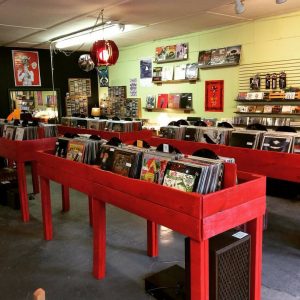Accessibility is one of three key elements to a vibrant and economically robust place. So how does walkability factor in and how can we improve upon it for downtown?
The weekend after Labor Day, Downtown Sioux Falls was a buzz with people here to experience two mainstay events for Downtown Sioux Falls—the Sidewalk Arts Festival and Germanfest. It was a wonderful opportunity for folks to explore the heart of Sioux Falls. People were everywhere!
The upward trajectory of downtown activity has been exciting to witness. It’s become a boomtown and it’s great to be a part of it. The only drawback however, is that with more activity comes more competition for space. This is most evident with cars, buses, cyclists, and pedestrians all trying to navigate the streets and sidewalks together.
It may not seem like it, but congestion and contested streets are actually a good problem to have. We just have to figure out the best way to choreograph the various modes of mobility into a harmonious ballet of place. To successfully manage these competing interests, it takes intentionality.
This competition for space came to a head that event-filled Saturday, September 8th. I heard from several people who felt uneasy while crossing streets. I had to exercise defensive walking myself while crossing the street with my wife and two young boys. A driver failed to notice that there were eight people in the crosswalk with the right-of-way. Thankfully, the driver yielded when I asked him to give way, but not without a retort.
Let’s face it, downtown can be a challenging environment to navigate, particularly in the warmer months when there is construction activity channeling drivers and pedestrians away from certain areas and into others. It can be frustrating. For one unfortunate individual it was beyond frustrating—it was terrifying. This person was struck by a car, warranting a trip to the hospital.
When I hear of situations like this, I feel compelled to act because I want people to have good experiences in downtown. I believe downtown offers the best way for people to connect and engage with their community through unique and enriching experiences. These potentially grave occurrences are a hindrance to that and indicate we might have an accessibility issue. It seems the best way to improve upon accessibility is by focusing on walkability.
In researching the walkability, I found some startling information. A pedestrian is struck by a car every four minutes in this country, according to estimates from the Governors Highway Safety Association. Every 90 minutes, a pedestrian is killed. That equates to roughly twice the number of fatalities as 9/11 happening each year. Bizarrely, we seem numb to this reality.
It seems like poor walkability is even a public health issue. Not only are people dying from auto accidents, but many suffer from higher obesity rates in less walkable cities, according to an extensive body of research. The walk score for Sioux Falls is 37 on a scale of 0-100, by the way.
Safety and health concerns aren’t the only reasons to care about walkability, though. It makes economic sense too. Take the example of Portland, Oregon. People drive an average of four miles less than the national average because it’s such a walkable city. According to Joe Cortright of City Observatory, this translates to savings for Portlanders that accounts for three percent of all income earned in the Portland metro area, which means millions of more dollars in the local economy. As a result, Portland has become a place where young, educated millennials want to live. This demographic has increased by fifty percent over the last two censuses, which has helped Portland’s tech and entrepreneurial scenes.
Not surprisingly, cities like Portland that are walkable are also sustainable. Less overall driving begets smaller carbon footprints, right? Big deal. Who cares, Joe? Well, if you care about quality of life, you should care about a more sustainable Sioux Falls. There is a correlation between quality of life and low carbon footprints per household in cities around the world, according to the Mercer Survey. Do these cities have a higher quality of life because they are sustainable? According to city planner and urban designer, Jeff Speck, the same thing that enhances quality of life makes cities sustainable—walkability.
That’s all well and good, but where do we begin to tackle this issue? In his book, Walkable City, Speck boils it down to four factors:
- There has to be a reason to walk—to go to work, to shop, etc.
- It has to be safe—an essential component, but not exclusive.
- It has to be comfortable—best supported by compact development.
- The walk needs to be interesting. Are there people there?
Speck says all four of these factors are needed to improve walkability. It makes sense then to focus on improving walkability in and around downtown, as elements of these four factors are already present. It would seem that pedestrian safety needs the most improvement however, given recent accounts.
Four years ago, Jeff Speck visited Sioux Falls and gave us some tactics to employ to enhance walkability. So too have other consultants like Charles Marohn and Robert Gibbs. All three emphasized the need to calm traffic by converting our one-way streets to two-way streets, and narrowing the traffic lanes.
There are other ways to improve walkability, though. The City is doing its part by repainting crosswalks. ADA compliant ramps were recently installed at a mid-block crossing on Phillips and on River Road. The City is also in the middle of assessing downtown’s inventory of street trees, which help calm traffic.
But what more can be done? DTSF and its Placemaking Committee are currently exploring options to enhance pedestrian safety in and around downtown that use a small scale, incremental approach. It’s going to take a collaborative effort though, including neighborhood associations and advocacy groups. I plan to follow up on our efforts next month to let you know what we are working on for 2019.
In the meantime, I hope that those of you reading this will help spread the message about walkability and sway your peers who may not be so convinced that walkability is critical. A cultural shift is needed. I invite you to be a part of it. If economic development, quality of life, and community health are important to you, then so too is walkability. We can’t afford to wait for the next person to get hit by a car before we do something about it.
In the meantime, I encourage you to watch Jeff Speck’s TED Talks and to join the conversation. Send me an email with your thoughts on the topic to joe@dtsf.com. I’d love to hear from you!
Sincerely,

 Joe Batcheller Joe Batcheller
DTSF President |
Jeff Speck on why walkability is important:
Jeff Speck on how to improve walkability:






















 3. Mrs. Murphy’s is the only Irish store in South Dakota.
3. Mrs. Murphy’s is the only Irish store in South Dakota.  7. Get the official St. Patrick’s Day button and support Special Olympics South Dakota.
7. Get the official St. Patrick’s Day button and support Special Olympics South Dakota. 






 Sarah is a jack of all trades who keeps the books in order whilst coordinating DTSF promotions such as the Burger Battle and Art & Wine Walk whilst spinning several plates on her head and telling killer jokes. We’d all lose our minds without Sarah on the team!
Sarah is a jack of all trades who keeps the books in order whilst coordinating DTSF promotions such as the Burger Battle and Art & Wine Walk whilst spinning several plates on her head and telling killer jokes. We’d all lose our minds without Sarah on the team!

 Sadie’s DTSF Wishlist:
Sadie’s DTSF Wishlist:


 Joe Batcheller
Joe Batcheller